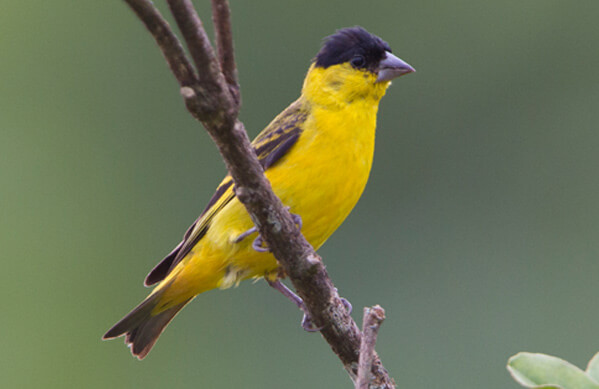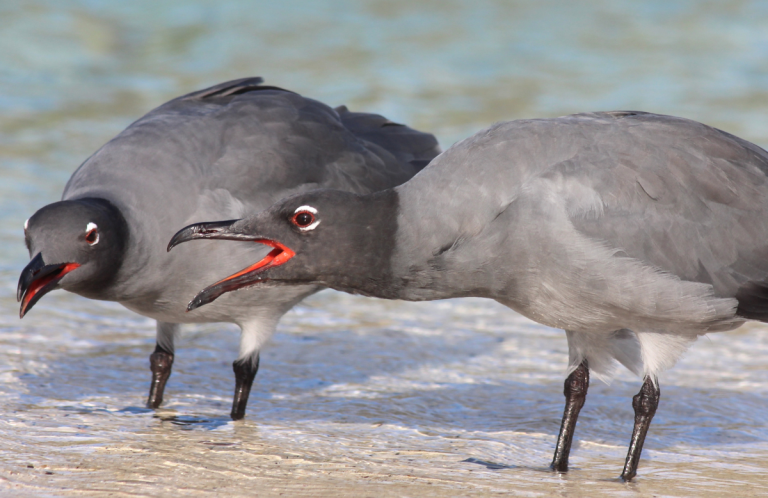 The Yellow-faced Siskin was initially described as a Californian species, since the first male type specimen was a captive bird in that state. But this bright yellow finch, which closely resembles the more familiar American Goldfinch, is actually native to South America.
The Yellow-faced Siskin was initially described as a Californian species, since the first male type specimen was a captive bird in that state. But this bright yellow finch, which closely resembles the more familiar American Goldfinch, is actually native to South America.
Like the Banded Cotinga and Lear's Macaw, the attractive Yellow-faced Siskin is highly sought-after as a cage bird. Widespread illegal trapping has led to its steep and rapid decline, leading to a Vulnerable classification on the IUCN Red List of Threatened Species.
Sign up for ABC's eNews to learn how you can help protect birds
This bird's Latin name commemorates English ornithologist William Yarrell, who wrote A History of British Birds, published in 1843, and first described the Bewick's Swan. Several other species are named in his honor, including the Critically Endangered Chilean Woodstar (Eulidia yarrellii). (Learn more about our efforts to save this rare hummingbird.)
Bird in a Cage
The Yellow-faced Siskin occurs in northeastern Brazil, where it is not very particular about habitat type or quality, occurring in lowlands, mountains, forests, and open areas. The species has also been recorded in northern Venezuela, although these sightings may be of escaped cage birds.
Despite illegal trapping, the Yellow-faced Siskin remained fairly common in Brazil until the beginning of the 1980s, when scientists and other researchers noted increased numbers of Yellow-faced Siskins being sold in local markets. Its decline also coincided with the increased popularity of the Atlantic Canary (Serinus canaria) with Brazilian bird breeders, who began hybridizing the two species.
Seed-feeding Singer
The Yellow-faced Siskin is related to the more numerous and familiar American Goldfinch and Pine Siskin, which are found across much of North America. Like these finches, it has a complex and melodious song composed of high-pitched, ringing notes.
In common with other members of the finch family, including the Evening Grosbeak and Rose-breasted Grosbeak, the Yellow-faced Siskin has a cone-shaped bill, adapted to hold and shell all types of seeds. Strong skulls, large jaw muscles, and powerful gizzards are other finch specializations for seed-eating.
Like many other birds, including the grosbeak species mentioned above and the Painted Bunting (not a close relative), this species is sexually dimorphic: The males and females look different, with the male sporting brighter plumage.

Oasis Araripe Reserve in Brazil is home to Yellow-faced Siskin, as well as the rare Araripe Manakin. Photo by Fabio Arruda
Refuge in the Araripe Reserve
The Oasis Araripe Reserve, purchased by ABC partner Aquasis in 2014, is a protected area that could be used to re-establish populations of Yellow-faced Siskin. The reserve was originally created to safeguard the critically endangered Araripe Manakin, which numbers only around 800 birds.
With ABC support, this reserve was just expanded by approximately 170 acres, doubling the size of the existing property and connecting it to a much larger area of national forest. This expansion will protect several freshwater springs, which serve as important water sources for local human communities as well as providing important nesting habitat for the manakin.
Aquasis plans to reforest other areas of the reserve with native plants grown in an on-site nursery. The reserve lodge has been refurbished and can now accommodate up to six visitors.
Special thanks to Weber Silva for assisting with this account. Weber, a member of Aquasis, is the ornithologist who discovered the Araripe Manakin, and is dedicated to its conservation.
Donate to support ABC's conservation mission!



















































